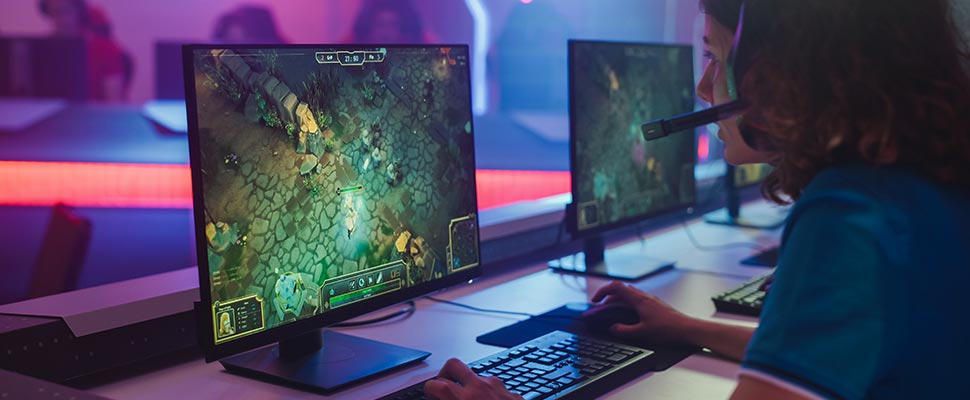Video Games, Also a Women’s World
More now than ever, a broader spectrum of identities can find themselves on mainstream media, series, movies, books, and yes, video games.

The Woman Post | Monica Liliana Pradilla
Listen to this article
Representation is a pretty general concept to read and hear about now. All around, people are sufficiently conscious of its importance and weight. Although, from a privileged point of view and from a business point of view, it is wise and a must-have to survive in today’s politically correct scenarios.
From a day-to-day perspective, it might not be that important if taken on from individual narratives. But, discussion aside, one thing is clear when discussing the fictional worlds we interact with and the narratives we’re told today: More now than ever, a broader spectrum of identities can find themselves on mainstream media, series, movies, books, and yes, video games.
Like it or not, the video games industry has positioned itself as one of the most important and the highest-grossing entertainment industries of our times. Its production rates and numbers worldwide speak loudly of a change in narrative dynamics and art forms in interaction that goes way beyond a point and shoots perspective or a traditional arcade game. From medieval, mythological, fantasy, cyberpunk, futuristic, dystopian, and apocalyptic worlds, the possibilities for storytelling become endless, the limitations blur, and the imagination of both creators and players meet no boundaries. This is the industry to be watching; here is where things are happening, culture is shifting, technology is being challenged, and cultural consumption is shifting.
There are many points from which a discussion around the world of video games might be boarded. Gaming is the most evident one as it is in this sphere that interactions between the player and the dynamics and logics planned for the game are also confronted with the real target. Although we’re living through a time in which the increase of women’s participation in competitive e-sports leagues and general gaming culture is evident, video games to this day continue to be regarded as man land, spaces primarily designed and dominated by men from all over the world. The problematics of such spaces are wide, bordering from general bullying to full-scale harassment, objectification, unrealistic standards of beauty, discrimination, and much more.
Also read: THE MOST IMPORTANT WOMEN IN THE VIDEO GAME INDUSTRY
Any woman who has taken a stroll down the world of video games can tell you how hard of a world to get into it is. The world of video games is one heavily biased place to be, both within the playing and the industry surrounding it. And not unlike what has happened with many more creative industries, assumptions are made, gender roles are assigned, standards are hard to meet, and authentic representation continues presenting a challenge.
Shifting the narrative and placing women on the center of game playing and narratives from a perspective that leaves gender roles, beauty standards, or male gaze objectification out of the dynamics continue to be a daily struggle for creators and professional female players alike. However, it is a battle worth fighting that breaks boundaries, re-signifies women’s roles, reinvents itself, and calls for the recovery of tales of survival, strength, and resilience. All of this could never be, could never happen without women looking into a mirror and being able to see themselves as the heroes of the story, not for the looks or the show-stopping bodies alone but for the strength, intellectual abilities, and feelings we’ve always had and that are finally being represented.
Examples of this are not necessarily new but certainly are groundbreaking and essential to take into account. Their evolution and, progressively made, adjustments to change the narratives from the voluptuous and lightly clothed female bodies (that had little or nothing to do when taken in context with the surroundings of the video games), and the unrealistic beauty standards of perfect and flawless complexions portrayed by women.
The list keeps growing and features an extensive lineup of incredible women from various backgrounds in very varied contexts and stories. From brand new stories to classics, finally giving its female characters the well-deserved chance to lead the way with women of color, scientists, warriors, and survivors without lacking in the least on story quality or aesthetics. Mirror’s Edge, Alien Isolation, Horizon Zero Dawn, Hellblade: Senua’s Sacrifice, Uncharted: The Lost Legacy, Assasin’s Creed: Legacy, Half-Life: Alix, The Last of Us Part II are just some examples of this.
Perhaps one of the most notable evolutions we see on these worlds is presented in the well-known beloved and established franchises like Tomb Raider, Resident Evil, Assasin’s Creed, and so on. Lara Croft is one of the most classic examples of this perspective. A pioneer in itself, the Tomb Raider video games initially introduced in 1996 featured the archeologist as a strong, intelligent, and bold woman. In a way, a counterpart for the Indiana Jones male adventurer type, with similar adventures and contexts. Along with Jill Valentine from the Resident Evil saga, both female heroines evolved and received new looks, more practical, with more clothes and logically placed proportions, both heavily criticized for not aligning with the classic and original portrayals of their characters and mostly met with resistance from the male audience of the games.
None of the edits made to the characters affected their abilities within the games or the game dynamics. Nor did they clashed with the worlds in which the stories took place. Instead, they responded to the ever-growing need for resignification and reclaiming women’s bodies for us. Heroines are ours, are like us, are real, and make the video games scene a women’s world.




